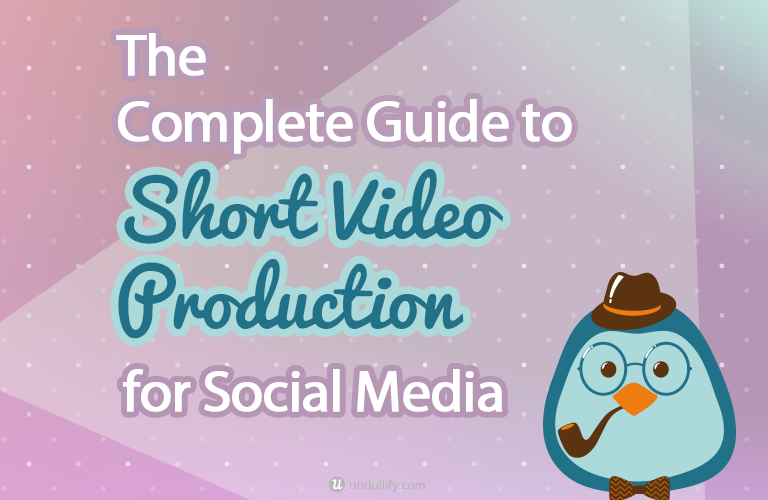The Complete Guide to Short Video Production for Social Media
ADRIENNE WOLTER | 4 MAY 2016

Video is the future of the web. As connections get faster and data plans get cheaper, the web has moved towards richer media and user experiences.
In 2015, Cisco predicted that “consumer internet video traffic will be 80% of all consumer internet traffic in 2019, up from 64% in 2014.” But even today, video is an incredible tool for growing your influence on the web, and especially on social media.
It used to be that if you were talking about video and the web, you were talking about YouTube. Even though YouTube is still a popular platform, more than ever video content is growing on platforms besides YouTube.
Even better, it is getting easier to create, with the proliferation of smartphones and tools for editing video on them.
In this article, we’re going to take a look at the state of video content on three platforms – Twitter, Instagram, and Facebook – and tools that exist on these platforms for editing your videos.
Then, we’ll go through a series of tips for producing content to succeed on these platforms and spread your influence on social media.
After all, on nearly every platform that accepts on-site video uploads, video content outperforms still images. Here’s how to succeed with videos on social media.
Video on Twitter
Twitter was slow to truly embrace native video. However, they did acquire several services to improve their video experience before finally turning on autoplay video a little under a year ago.
In addition to autoplaying native video, Twitter autoplays gifs and Vines. Videos and Vines are silent unless the user clicks them to turn on sound.
Videos can be shot and lightly edited right in the Twitter smartphone app, or uploaded directly from your computer. Or, you can use one of Twitter’s sister services to share your videos.
Vine
Vine made quite a splash when it entered the scene back in early 2013. This service, snapped up by Twitter before it launched, allows users to share six second looping video clips. Early reaction to Vine was mixed, with some users incredulous that anything worthwhile could be shared in six seconds. However, it has proven a good accompaniment for Twitter and its 140 character limit.
Users can shoot and edit Vine videos right on their smartphone with the Vine app.
Periscope
Another service that Twitter acquired before its launch, Periscope was officially opened to the public a little over a year ago. Periscope, which also operates in its own app despite being closely tied to Twitter, allows users to attract viewers to live video streams.
Some called it a copycat service to Meerkat, a similar live video streaming service that skyrocketed in popularity during SXSW 2015, and was subsequently cut from the Twitter social graph.
Shooting video with Periscope is quite easy – users just use the front-facing camera on their smartphone.
Livestream attendees can chat with the person streaming video, making for a truly interactive video experience.
After the video session is over, Periscope videos can be rewatched for 24 hours before they disappear.
Video on Instagram
A few months after Vine hit the scene, Instagram launched their own competing feature, allowing users to upload videos up to 15 seconds in length.
These videos also loop, and they appear in the Instagram feed just like regular photos do, silently autoplaying as soon as they appear. Filters can be applied, just like regular images.
Hyperlapse
https://www.instagram.com/p/BEmSwAdSJUS/
Like Twitter, Instagram has been going the multi-app route, offering up a variety of single-purpose companion apps to accomplish different things.
Hyperlapse allows users to shoot up to 45 minutes of video, stabilize it, and speed it up to up to 12 times the regular speed. Then users can send the final video back to Instagram to apply filters and other editing effects.
Boomerang
https://www.instagram.com/p/9JN4fdmZmW/
Boomerang is a tiny standalone app for Instagram that shoots a quick burst of 5 photos in about a second. It then turns them into a back-and-forth looping one second gif that you can quickly and easily post on Instagram.
Video on Facebook
Facebook was the first of the major social networks to enable autoplay videos, a move that pretty much made the ALS Ice Bucket Challenge the incredible success it was in the summer of 2014. Soon after, Facebook introduced autoplay video ads.
The move was unpopular at the onset, with some users complaining of huge data fees. However, the reach of the feature won out, and in late 2014, Facebook videos viewed per day passed YouTube. The engagement on the autoplay videos didn’t match that of YouTube, of course, but it still showed the promise of video content on the network.
Facebook Live
Following in the footsteps of Twitter Periscope, Facebook launched a live video feature to famous celebrities and influencers last year, and later opened the feature up to users and groups. Users can interact with Reactions and comments, and the videos are rewatchable afterwards.
Producing Video Content for Social Media
Compared to images and other types of social posts, videos draw a lot of attention in users’ feeds because the action jumps out at them. Especially if a video can draw a viewer in in the first couple of seconds, they are more likely to engage or at least stick around to view more.
Keep It Short
The key to finding success with social video is keeping things concise.
Vine and Instagram Video already set limits. Instagram’s Boomerang app takes this to an extreme, limiting users to a single second. What can you capture in a few seconds? Well, a few seconds of video are great for capturing a mood or an atmosphere. This is the exact philosophy Apple had when they unveiled Live Photos with the iPhone 6s.
Even if you are not limited by the platform, it still pays to keep things short and sweet. Viewers have short attention spans, and they are more likely to stick around for the whole thing if you present something to them that is shorter than a minute.
Reel Viewers In
Just like how the majority of readers on the web will only read the title of your blog post, most viewers will only see the first few seconds of your video. How will you reel them in?
Graham Mudd, Facebook’s director of ads product marketing had the following stats to share with Business Insider:
- 55% of people who watch the first three seconds of an add will watch the next 10 seconds
- 45% will make it all the way to the end of the video
Three seconds is the magic number here – this is how long it takes for Facebook to consider it an intentional “view,” which counts for engagement and helps your post reach new organic viewers.
No matter what network you are working on, grip viewers immediately with something that really jumps off their feed. The many recipe videos that proliferate all over Facebook all do the same thing: they start with a glimpse of the finished product, then jump right into the recipe.
Silently Understandable
Around 50% of Facebook videos are watched without sound, so it is vital that you are able to make an impact with your video muted. If the viewer engages with the video, awesome; if they just pause while scrolling, you better find some other way to hold their attention.
Many popular Facebook videos are designed with sound almost as an afterthought. They have music in the background, but any necessary information is spelled out on screen.
The same is often true of Instagram videos and Vines, which are much more about the visuals than the audio. Instagram even has an audio-stripping button in their app.
Facebook also has an auto-captioning feature, unveiled this past February, which will automatically generate closed captions for your videos. You can view and approve them before posting your video. This is great if you have a video where narration is necessary to understand what is going on.
Lighting and Color
As with all other media content on the web, good production values are important. Even if you are just shooting with your smartphone, make sure your scene is well-lit, and it’s even better if you can incorporate bright colors.
Colorful scenes and shots help you break up the monotony of the blue and white feed prevalent on most networks.
Wrapping Up
No matter your network of choice, there is no doubt that video content is going somewhere on the web.
Some predict that live video and interactivity are the future of media on the web, pointing to services like Twitch, a livestreaming platform for gamers. Others have pointed to live video services being used for more mundane uses, a sort of “future of hanging out.”
These users aren’t taking advantage of livestreams to shoot political events or even play video games; they are showing others the inside of their fridges.
Either way, video is an incredible force for creating engagement on Facebook, Twitter, and Instagram, where autoplay media in the feed is the most eye-catching content users scroll by.
And although your Facebook feed may seem to suggest otherwise, video is not yet totally saturated. It takes just a little bit more effort to take the time to produce a video, something your competitors may not be doing yet.
If you had the opportunity to do something that would definitely set you apart from your competitors and grow your engagement, why on earth wouldn’t you?
Just don’t forget the tenets of video production for social media: keep it short, reel viewers in in the first few seconds, keep it silent or at least comprehensible without sound, and make sure your scene is colorful and brightly lit.
What other practices would you say are must-haves for social video? Share your tips in the comments below!


